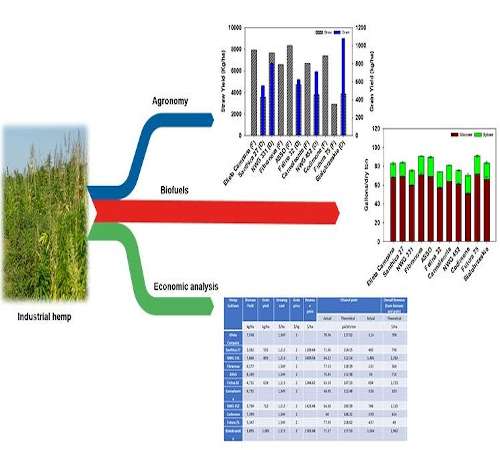By Katie Pratt

These graphs show the results of a study that compared 11 hemp cultivars' ability to produce biofuels and bioproducts.
Dual-purpose industrial hemp cultivars show the best potential for coproduction of biofuel and bioproducts, according to University of Kentucky College of Agriculture, Food and Environment study.
In the study led by Jian Shi, UK assistant professor in the Department of Biosystems and Agricultural Engineering, the dual-purpose cultivars that had the best biofuel potential, which uses the stalk, also produced grain.
In a previous study, Shi’s team showed that hemp has biofuel-producing potential comparable to other bioenergy crops like kenaf, switchgrass and sorghum. Those results were published in Bioresource Technology Journal.
“The biofuels market fluctuates, much like the hemp market, so it is very important for the crop to have coproducts to help offset potential losses when the market trends downward,” Shi said. “Hemp has more potential for coproducts than other current biofuel feedstocks.”
In his most recent study, Shi’s team evaluated 11 hemp cultivars from all over the world. They planted cultivars at UK’s Spindletop Farm and at Robinson Center for Appalachian Resource Sustainability under the leadership of the late David Williams. The cultivars included six that produced fiber only and five that produced fiber and grain. The study explored each cultivar’s ability to produce biofuels, how each performed with a laboratory pretreatment and enzymatic hydrolysis, which is designed to enhance biofuel yields, and projected economic returns.
All dual-purpose cultivars had higher economic returns than the fiber-only cultivars. The top performing cultivars were Bialobrzeskie from Poland and NWG 331 from Colorado. Bialobrzeskie had estimated returns from the sale of the grain and projected biofuel production of $1,564 per hectare, and NWG 331 had estimated returns of $1,482 per hectare. NWG 331 had the highest biomass yield and the second highest grain yield of all cultivars. Bialobrzeskie had the highest grain yield.
“These combined evaluations show that industrial hemp has significant potential to become a promising regional commodity crop for producing both biofuels and value-added products,” Shi said. “Further research is needed into the crop’s agronomic practices, post-harvest processing, biofuel conversion and other potential hemp coproducts.”
As part of the project, Shi partnered with the U.S. Department of Energy’s Idaho National Laboratory. The laboratory is home to a DOE-funded Biomass Feedstock National User Facility and feedstock supply and logistics research and development center. Researchers at UK and INL plan to assemble a sample collection and characterization of the hemp biomass cultivars in the future. This collection would add to the existing collection of more than 7,500 biomass samples as a resource available to other academic researchers and industry professionals across the United States.
Source : uky.edu